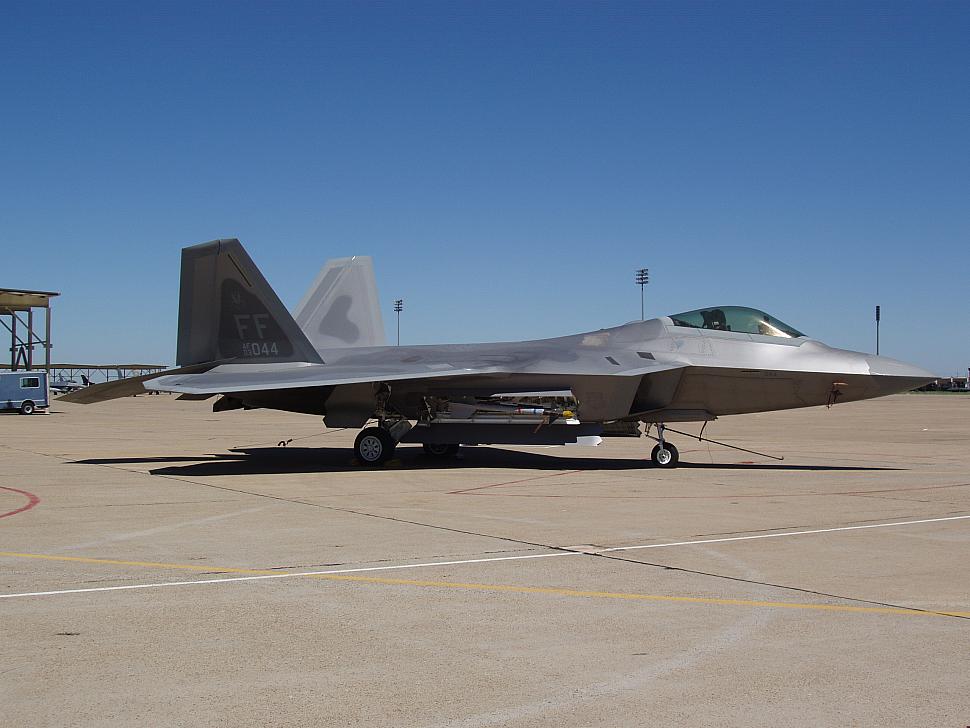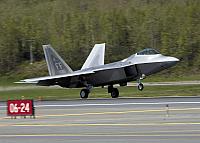Fighter Jet News
F-22 Raptor News
Robins AFB selected for software maintenance on F-22 Raptors
December 22, 2006 (by
Lieven Dewitte) -
The Air Logistics Center's at Robins Air Force base will be the repair station for most of the software on the software-intensive F-22 Raptor, which contains about 2 million lines of code.

The decision means Robins will fill a key role in AFMC's sustainment plan, updating software for an integrated avionics suite that reportedly gives the F-22 pilot a "God's eye view" of the battlefield and the on-board systems to do something about it.
Robins already performs similar work on avionics systems for a broad range of Air Force aircraft.
The F-22 weapon system eventually will be managed and sustained by Ogden Air Logistics Center at Hill Air Force Base, Utah. Oklahoma City Air Logistics Center will support the supersonic aircraft's Pratt and Whitney engines.
Both Ogden and Oklahoma City will work some software issues, but the Robins center will receive the bulk of the software taskings.
The software
The software that provides the avionics system's full functionality is composed of approximately 1.7 million lines of code. Ninety percent of the software is written in Ada, the Department of Defense's common computer language. Exceptions to the Ada requirement are granted only for special processing or maintenance requirements.
The avionics software is integrated in three blocks, each building on the capability of the previous block. Each block cycle is a sequence of subsystem deliveries, integration testing at the Avionics Integration Lab (AIL) at Boeing, and then delivery to Lockheed Martin in Marietta, Ga., for final integration into the aircraft and check out, as well as support to the aircraft.
USAF F-22A no. 03-4044 assigned to the 27th FS and seen here on June 24th, 2006 at Hill AFB, Utah. [Photo by Duane Kaiser]
Robins already performs similar work on avionics systems for a broad range of Air Force aircraft.
The F-22 weapon system eventually will be managed and sustained by Ogden Air Logistics Center at Hill Air Force Base, Utah. Oklahoma City Air Logistics Center will support the supersonic aircraft's Pratt and Whitney engines.
Both Ogden and Oklahoma City will work some software issues, but the Robins center will receive the bulk of the software taskings.
The software
The software that provides the avionics system's full functionality is composed of approximately 1.7 million lines of code. Ninety percent of the software is written in Ada, the Department of Defense's common computer language. Exceptions to the Ada requirement are granted only for special processing or maintenance requirements.
The avionics software is integrated in three blocks, each building on the capability of the previous block. Each block cycle is a sequence of subsystem deliveries, integration testing at the Avionics Integration Lab (AIL) at Boeing, and then delivery to Lockheed Martin in Marietta, Ga., for final integration into the aircraft and check out, as well as support to the aircraft.
- block 1 is primarily radar capability, but Block 1 does contain more than 50 percent of the avionics suite's full functionality source lines of code (SLOC) and provides end-to-end capability for the sensor-to-pilot data flow.
- Block 2 is the start of sensor fusion. It adds radio frequency coordination, reconfiguration, and some electronic warfare functions.
- Block 3 encompasses full sensor fusion built on enhanced electronic warfare and CNI functions. It has an embedded training capability and provides for electronic counter-counter measures (ECCM).
- Block 3.1 adds full GBU-32 Joint Direct Attack Munition (JDAM) launch capability and Joint Tactical Information Distribution System (JTIDS) receive-only capability.
- Block 4 software (as proposed) will be post-EMD. It is scheduled to be integrated on the Initial Operational Capability (IOC) F-22s and will likely include helmet-mounted cueing, AIM-9X integration, and Joint Tactical Information Distribution System send capability.
Related articles:
Forum discussion:
Tags
- Wings combine strengths to solve Raptor issue ( 2006-08-10)
- F-22A Raptor took long road to initial operational capability ( 2005-12-27)
- F-22 Raptor receives latest integrated avionics software package ( 2003-02-12)
- Newest advanced integrated avionics software flown for first time aboard the F-22 Raptor ( 2002-05-07)
- First flight of Raptor 4005 armed with block 3.0 avionics ( 2001-01-05)
- F-22 Raptor news archive
Forum discussion:
- Start a discussion about this article in the F-22 forum.
Tags
Additional images:

F-22A Raptor #04-4065 lands at Elmendorf AFB, Alaska, on Tuesday, May 23, 2006. Raptors from the 27th FS at Langley AFB, Virginia, are supporting Exercise Northern Edge 2006. The Air Force selected Elmendorf as the home for the next operational F-22 squadron. The base will receive 36 Raptors, with the first jet expected in fall 2007. [USAF photo by Tech. Sgt. Keith Brown]
